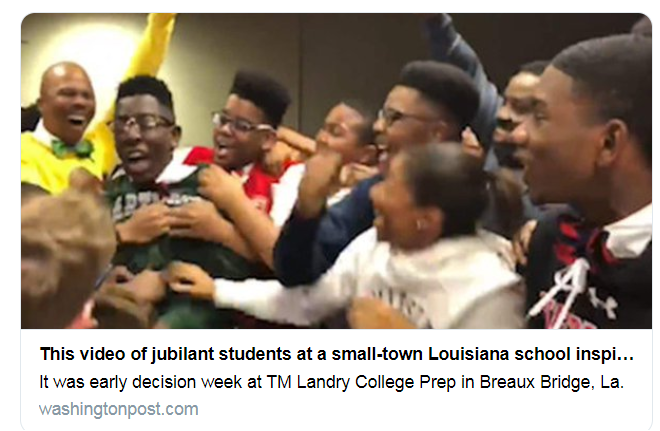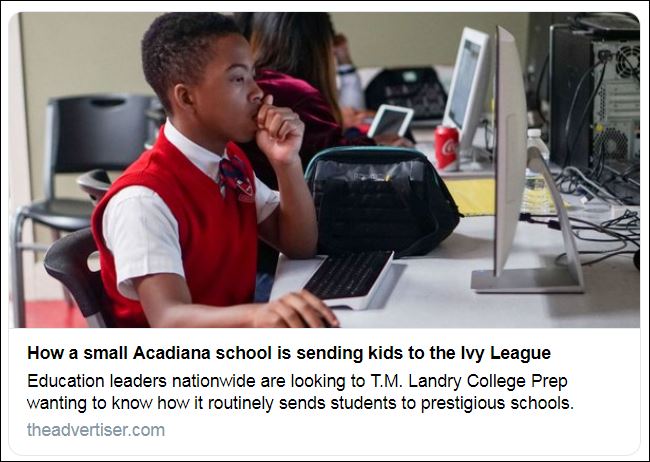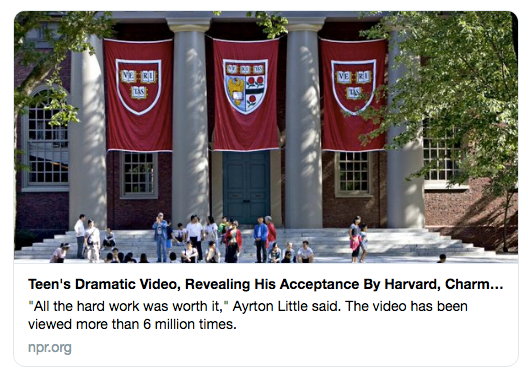For two years, incredible claims from a small Louisiana school were promoted unquestioningly by mainstream news outlets. Why does this keep happening, and what can we do about it?
By Alexander Russo
It’s a bittersweet experience reading Friday’s Erica Green and Katie Benner New York Times blockbuster, Louisiana School Made Headlines for Sending Black Kids to Elite Colleges, which describes how the much-admired private school TM Landry faked student transcripts and subjected students to abuse.
There is so much to admire about the piece, including the deep reporting, which exposes a horrible fraud, and the powerful writing behind the piece. The accompanying images and video are compelling additions.
At the same time, it’s deeply upsetting to read about how school leaders persuaded desperate parents and vulnerable students to participate in what is apparently an abusive scam that has hindered children’s educations and thrown a shadow over their futures.
But there is at least one other reason to be upset reading the story: It serves as a vivid reminder of a chronic media failure to check out feel-good stories before publishing them — or to knock them down quickly when they appear.
For the last two years, viral videos from TM Landry have spread across the internet with the help of mainstream news outlets like NPR and the Washington Post, some of whom published glowing stories about the school’s claims of a 100 percent graduation rate and accepted the school’s highly questionable methods with little apparent concern or skepticism.
Why didn’t anyone catch this earlier? Why didn’t anyone — including myself — raise the alarm before now? And what can be done to stop or at least limit the perpetuation of these kinds of stories in the future?
“A high school student in front of a laptop, surrounded by classmates, dressed in college gear. A moment of suspense, and then …” This was a scene repeated over and over again,” narrates this Times video (above). “Students from one Louisiana private school opening acceptance letters from their dream colleges.”
There is a long, sad history of education journalism that turns out to be insufficiently skeptical about claims of success.
Way back in the early 2000s, lack of scrutiny around unproven ideas and programs was so prevalent that I ran a regular “Hype Warning Alert” feature on my blog.
In the second half of the 2000s, there was an unfortunate wave of stories in which “100 percent” graduation rates and massive test score increases were reported to the public, only to have it later revealed that there were caveats and problems that should have been noted from the start.
More recently, the District of Columbia’s claims of record-setting school graduation rates turned out to have been greatly inflated by the district and passed along by the media.
And now we have TM Landry.
The Times story doesn’t question the school’s graduation rate claims, but it raises numerous questions about the school’s methods and reports that the school falsified transcripts, rewrote college application essays, and physically abused students.
Each week, The Grade takes a deeper look at education journalism. Sign up for the free newsletter.

Here’s the 2017 Washington Post story — This video of jubilant students at a small-town Louisiana school inspired millions.
As noted in the Times, TV shows like Today, Ellen, and CBS This Morning all ran feel-good segments about the school.
But there are several other outlets that helped popularize the Landry story. A quick Google search shows stories touting the school’s miraculous accomplishments from outlets including the Washington Post, NPR.com, NOLA.com, Boston Globe, and the Lafayette Daily Advertiser.
I’m pretty sure that I shared a TM Landry video at least once. You may have done so, too.
It’s unclear exactly how much these outlet’s reporters did in the way of on-the-ground reporting or independent verification.
Some seemed to have talked to parents and students, but it’s unclear if they did so in person, in front of school officials, relying on subjects picked for them by the school rather than finding their own people to interview. Also unknown is whether they asked the school to back up its claims regarding test scores and graduation rates.
“The [Ivy League] flags are the first thing you notice when you drive into the parking lot of T.M. Landry College Prep,” opens a Lafayette Daily Advertiser version of the story, which suggests that a reporter visited the school. But the Advertiser’s story appears to lean heavily on the school’s version of events, reporting that “all of its graduates attend four-year universities, many on full scholarships. Most have ACT scores in the high 20s and 30s.”
The Washington Post version of the story doesn’t do all that much better. It attributes claims to the school, but still leaves the reader with the strong impression that what the school said is true: “The graduation rate is 100 percent at TM Landry College Prep, an independent school in Breaux Bridge that began in 2005 with five students labeled as ‘black troublemakers,’ the school says.”
A WBUR Boston Public Radio story plays it safer, sticking to a description of a viral video and some quotes from the students. The NPR version of the story also focuses primarily on the massive reaction to the video rather than the school’s claims about student scores and graduation rates.

A 2017 story from the Daily Advertiser: T.M. Landry: A look at the Breaux Bridge school sending kids to the Ivy League
What do we do now, other than promise not to let this happen again and again?
Several journalists have pointed out that key parts of the Landry narrative and coverage remain accurate, despite the Times’ reporting. Indeed, so far as I know, the kids shown on video did get accepted, and none of the kids on video are among those who have been found to have won acceptance based on false information provided by TM Landry.
However, the ground rules for reporting on miracle schools should be clear by now: No passing along a school’s claims of test scores or graduation or college acceptance claims without independent verification. At this point, claims of 100 percent graduation rates should raise immediate red flags.
Pin the Times story to your bulletin board as yet another reminder against the temptation to write up feel-good stories without a thorough vetting, no matter how strong the urge may be.
Marta Jewson, the education reporter for New Orleans’ The Lens, asked on Twitter, “what should news orgs do with the ‘good news’ stories previously published?”
It’s a good question. My feeling is that media outlets that ran the feel-good version of the story should correct or update their stories and post prominent corrections on the original versions.
The Teacher Project’s Sharon Lurye proposed that outlets take one step further. “They should publish editorials reflecting on how they could have faced that story with more skepticism,” Lurye responded on Twitter.
So far as I know, that hasn’t happened — yet. But it should.
After having been contacted by The Grade, the Washington Post added a note to its 2017 story that it has been updated. There’s also a Valerie Strauss blog post about the scandal.
NOLA.com took things one step further, publishing a new piece reporting that the school had been accused of falsifying transcripts, with a link to its own previous coverage and to the Times report.
The Daily Advertiser story about TM Landry remains unchanged, far as I can tell.
Some might argue that it’s unreasonable to expect media outlets and daily news reporters to catch things before they go out or even to correct or update past stories based on new information. I certainly heard that enough last year when the DCPS graduation rate scandal was revealed.
But I don’t agree. I think that limiting publication of unverified claims and correcting stories when new information arises are difficult but essential activities. And that’s not all. I also think journalists should step up and begin making each other more accountable for each other’s work. It’s not enough to stay away from a story that seems fishy. No fair saying you ‘thought that something was off’ about the story after the story has been debunked.
Send a note, raise a flag. We all have to help each other.
Related columns:
How the DeVos resignation rumor went viral – and what to do next time
How the Washington Post missed the DC schools graduation rate scandal so badly, for so long
ABOUT THE AUTHOR

Alexander Russo
Alexander Russo is founder and editor of The Grade, an award-winning effort to help improve media coverage of education issues. He’s also a Spencer Education Journalism Fellowship winner and a book author. You can reach him at @alexanderrusso.
Visit their website at: https://the-grade.org/











